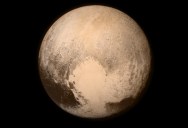The Clearest Photo of Pluto Yet
by twistedsifter

Pluto nearly fills the frame in this image from the Long Range Reconnaissance Imager (LORRI) aboard NASA’s New Horizons spacecraft, taken on July 13, 2015, when the spacecraft was 476,000 miles (768,000 kilometers) from the surface. This is the last and most detailed image sent to Earth before the spacecraft’s closest approach to Pluto on July 14. The color image has been combined with lower-resolution color information from the Ralph instrument that was acquired earlier on July 13.
This view is dominated by the large, bright feature informally named the “heart,” which measures approximately 1,000 miles (1,600 kilometers) across. The heart borders darker equatorial terrains, and the mottled terrain to its east (right) are complex. However, even at this resolution, much of the heart’s interior appears remarkably featureless—possibly a sign of ongoing geologic processes. [source]

New Horizons‘ almost 10-year, three-billion-mile journey to closest approach at Pluto took about one minute less than predicted when the craft was launched in January 2006. The spacecraft threaded the needle through a 36-by-57 mile (60 by 90 kilometers) window in space—the equivalent of a commercial airliner arriving no more off target than the width of a tennis ball.
Because New Horizons is the fastest spacecraft ever launched—hurtling through the Pluto system at more than 30,000 mph, a collision with a particle as small as a grain of rice could incapacitate the spacecraft. Once it re-establishes contact Tuesday night, it will take 16 months for New Horizons to send its cache of data—10 years’ worth—back to Earth. Its flyby of Pluto and Pluto’s system of at least five moons on July 14 will complete the initial exploration of the classical solar system while opening the door to an entirely new realm of mysterious small planets and planetary building blocks in the Kuiper Belt. [source]

In February of 2007, New Horizons passed Jupiter and the ever-active Jovian moon Io. In this montage, Jupiter was captured in three bands of infrared light making the Great Red Spot look white. Complex hurricane-like ovals, swirls, and planet-ringing bands are visible in Jupiter’s complex atmosphere. Io is digitally superposed in natural color. Fortuitously, a plume was emanating from Io’s volcano Tvashtar. Frost and sulfuric lava cover the volcanic moon, while red-glowing lava is visible beneath the blue sunlight-scattering plume. The robotic New Horizons spacecraft is on track to arrive at Pluto in 2015. [source]
Trending on TwistedSifter








